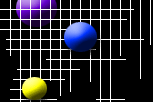
The Dragonfly is the first custom tagger to use the M-FLO design concept. Another CTDYNE exclusive!
Why M-FLO?
Imagine
if you will, the spread of light from a maglight flashlight with a focusable beam. For items that are up close and cover a
wide area, the energy from the bulb can be adjusted to illuminate a larger area. This works well for illuminating multiple
subjects or items that are close. However, the energy from the bulb is dispersed over such a wide area that it will not illuminate
at any distance.
If
the beam of light is adjusted so that the energy from the bulb is concentrated into a small area, the light will illuminate
objects at a much greater distance. However the light pattern is so small it becomes difficult to illuminate moving items
or multiple items at the same time.
This
is the quandary that hobby level laser tag builders have been facing since the first person built their own lens assembly
for use on a custom laser tag unit.
If
the components of a lens assembly are optimized for long distance shots, typically it will be difficult to tag an opponent
at close range, especially if the target is moving. If the lens assembly is set up for effective close range work, long range
performance will suffer. As a result the design of most laser tag optics is a compromise. Typically the focal length is set
to produce acceptable range with out giving up the ability to work at closer ranges. Usually this means that the optics package
is not efficient at ether end of the range spectrum. But usually works well somewhere in the middle.
Enter
the M-FLO. The Multiple Focal Length Optics design concept is a way of overcoming the limitations of a single focal length
system, without having to mechanically change the focal length to be effective for multiple targets at close range or targets
that are simultaneously at multiple ranges.
In
the case of the Dragonfly, the two optic assemblies, or barrels, fire simultaneously. The focal length in each barrel is set
for a specific distance or range. This custom tagger has excellent coverage from 50 to 800 feet.
If more barrel assemblies
of the proper configuration are added to the design of a custom tagger, even greater coverage can be achieved. A design based
on a GE minigun might lend itself well to the M-FLO design concept. Of course focal length is only one element of a high performance
optic assembly. Proper selection of components such as the lens and infrared LED along with suitable drive current to the
IR LED are all factors that contribute to a winning combination in the field.
The V-206 Maverick was built to Mike's specs. It is his first new personal V-2 tagger in over
a decade. This unit will replace the L.A.C.S.R. and will be used as Mike's main battle tagger. The Maverick was designed
from the start to accept a wide array of accessories that can be easily attached and removed without tools, as conditions
in the field warrant. The accessory rails on both sides, and the one running the length of the top, make reconfiguring
the Maverick a snap. The major components are equipped with thumb screw fasteners for easy installation
and removal.
Controls for items like the night vision scope and the 5" spot light attachment are located on
the tagger in such a fashion that they can be activated while keeping both hands in battle position. The battery onboard the
Maverick has enough capacity to last for days, unless the spot light is used often. Then the battery pack can be recharged
in the tagger by simply removing the screw in cap on top, and plugging in the charger.
The small lighting module at forward top center, contains the tunnel light red LED, close quarters
battle IR LED, and three muzzle flash bulbs.
The Night Ops Module (N.O.M.) mounts to the top accessory rail and is the base for all three low
light accessories, the 30mm red dot, the night vision scope and the 5" spot light. Any combination of these four items
can be used together.
The Maverick uses the complete optics assembly from the legendary V-2 Firestorm. These are some of
the finest factory optics ever produced for Laser Tag applications.
All three low light accessories can be mounted on the N.O.M. at once. In all practicality though, only one
or two will be used at the same time.
The electrical connection and the on-off button for the 5" spot light can be seen just above the trigger
group.
The subcomponents all have connectors to aid in disassembly for repairs. All fasteners are allen type. The
rechargeable battery pack is made up of twelve NiMH sub C cells. The pack is rated at 2,200 mAh, 14.4 volts. The battery
pack was configured to fit in the allowable space inside the Maverick. To the left of the battery pack is the custom
regulator board Duncan made to supply the proper voltage to the V-2 Firestorm board, located at the forward end.
The custom, hand built aluminum trigger group mounts thru the plastic housing to an inner aluminum
mating part. Four 6x32 button head screws and one electrical connector is all it takes to remove or install this one-of-a-kind
component.
Just some of the custom aluminum sheet metal work required to meet the design specs of the V-206 Maverick.
The over-all fit, form and function of this custom tagger turned out near flawless.
|

